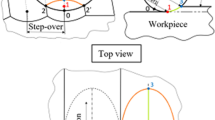Abstract
The effect of tool orientation on the final surface geometry and quality in five-axis micro-milling of brass using ball-end mills is investigated. Straight grooves with a semicircular cross section are cut with different tool inclination and tilt angles, and the resulting surfaces are characterized using an optical profilometer and microscope. Micro-milling cutting forces are recorded synchronously with spindle electric current and cutting motions in order to investigate the correlation between the tool orientation and the achieved surface quality. Results of various cutting experiments and analysis of the final surface geometry show that varying the tool orientation reduces rubbing of the material at the bottom of the grooves, which often occurs in ball-end milling of brass, and improves the final surface quality. The experimental analysis for surface roughness shows that applying a tool inclination angle of 15° can considerably improve the surface roughness at the bottom of the grooves. Analysis of static and averaged peak-to-valley (P-to-V) values of the cutting forces show that the static cutting force values are reduced by half when the tool inclination was increased from 0 to 15°. P-to-V cutting force values in along-the-feed direction were also decreased in the inclined machining.
Similar content being viewed by others
References
Wang J, Gong Y, Abba G, Cao J, Shi J, Cai G (2007) Micro milling technologies for MEMS. MEMSTECH, Ukraine: 86-95
Liu X, DeVor RE, Kapoor SG (2007) Model-based analysis of the surface generation in microendmilling-part1: model development. ASME J Manuf Sci Eng 129:453–460
Subbiah S, Melkote SN (2004) On the size effect in micro-cutting at low and high rake angles. Proceedings of IMECE04: 485-493
Liu X, Devor RE, Kapoor SG (2006) An analytical model for the prediction of minimum chip thickness in micromachining. ASME J Manuf Sci Eng 128:474–481
Filiz S, Conley CM, Wasserman MB, Ozdoganlar OB (2007) An experimental investigation of micro-machinability of copper 101 using tungsten carbide micro-end mills. Int J Mach Tools Manuf 47:1088–1100
Lee HU, Cho DW, Ehmann KF (2008) A mechanistic model of cutting forces in micro-end milling with cutting-condition-independent cutting force coefficients. ASME Journal of Manufacturing Science and Engineering 130
Koo JH, Heisel U (2007) Mechanistic cutting force model for micro ball-end milling. International Conference on Micro Manufacturing, ICOMM 2007, Clemson University, North Carolina
Uriarte L, Azcarate S, Herrero A, Lopez de Lacalle LN, Lamikiz A (2008) Mechanistic modeling of the micro end milling operation. Proc IME B J Eng Manufact 222:23–33
Jin CZ, Kang IS, Park JH, Jang SH, Kim JS (2009) The characteristics of cutting forces in the micro-milling of AISI D2 steel. J Mech Sci Technol 23:2823–2829
Barakchi Fard MJ, Feng HY (2010) Effective determination of feed direction and tool orientation in five-axis flat-end milling. ASME Journal of Manufacturing Science and Engineering 132
Vickers GW, Quan KW (1989) Ball-mills versus end-mills for curved surface machining. ASME J Eng Ind 111:22–26
Antoniadis N, Bilias N, Savakis C, Maravelakis E, Petropoulos G (2003) Influence of machining inclination angle on surface quality in ball end milling. Proceedings of the International Conference on Advances in Materials and Processing Technologies, 8-11 July 2003, Dublin, Ireland, 4 p
Ko TJ, Kim HS, Lee SS (2001) Selection of the machining inclination angle in high speed ball end milling. Int J Adv Manuf Technol 17:163–170
Daymi A, Boujelbene M, Linares JM, Bayraktar E, Ben Amara A (2009) Influence of the workpiece inclination angle on the surface roughness in ball end milling of the titanium alloy Ti-6AL-4V. J Achiev Mater Manuf Eng 35:79–86
Ozturk E, Tunc LT, Budak E (2009) Investigation of lead and tilt angle effects in 5-axis ball-end milling processes. Int J Mach Tools Manuf 49:1053–1062
Barakchi Fard MJ, Feng HY (2009) Effect of tool tilt angle on machining strip width in five-axis flat-end milling of free-form surfaces. Int J Adv Manuf Technol 44:211–222
Foy K, Wei Z, Matsumura T, Huang Y (2009) Effect of tilt angle on cutting regime transition in glass micromilling. Int J Mach Tools Manuf 49:315–324
Barakchi Fard MJ, Bordatchev EV (2011) Experimental study of the effect of tool orientation on surface quality in five-axis micro-milling of brass using ball-end mills. Proceedings of NAMRI/SME 39: NAMRC39-4732, 6 p
Barakchi Fard MJ, Bordatchev EV, Tauhiduzzaman M (2012) Experimental study of the effect of tool orientation on cutting forces in five-axis micro-milling of brass. Proceedings of the 7th International Conference on MicroManufacturing ICOMM 61: 411-416
Li H, Feng HY (2004) Efficient five-axis machining of free-form surfaces with constant scallop height tool paths. Int J Prod Res 42:2403–2417
Chiou CJ, Lee YS (2002) Swept surface determination for five-axis numerical control machining. Int J Mach Tools Manuf 42:1497–1507
ISO25178-2 (2008) Geometrical product specifications (GPS)—surface texture: Areal. Part 2. Terms, Definitions and Surface Texture Parameters
Author information
Authors and Affiliations
Corresponding author
Rights and permissions
About this article
Cite this article
Fard, M.J.B., Bordatchev, E.V. Experimental study of the effect of tool orientation in five-axis micro-milling of brass using ball-end mills. Int J Adv Manuf Technol 67, 1079–1089 (2013). https://doi.org/10.1007/s00170-012-4549-6
Received:
Accepted:
Published:
Issue Date:
DOI: https://doi.org/10.1007/s00170-012-4549-6



